Celtic mythology
| Part of a series on |
| Celtic mythologies |
|---|
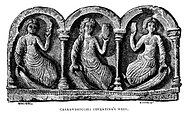 |
Celtic mythology is the body of
The supernatural race called the
Overview
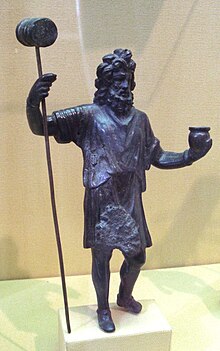
Though the Celtic world at its height covered much of western and central Europe, it was not politically unified nor was there any substantial central source of cultural influence or homogeneity; as a result, there was a great deal of variation in local practices of
The nature and functions of these ancient gods can be deduced from their names, the location of their inscriptions, their iconography, the Roman gods they are equated with, and similar figures from later bodies of Celtic mythology.
Celtic mythology is found in a number of distinct, if related, subgroups, largely corresponding to the branches of the Celtic languages:
- Ancient Celtic religion (known primarily through archaeological sources rather than through written mythology)
- mythology in Goidelic languages, represented chiefly by Irish mythology[2] (also shared with Scottish mythology)
- mythology in Brittonic languages
Historical sources
As a result of the scarcity of surviving materials bearing written
Rome introduced a more widespread habit of public inscriptions, and broke the power of the druids in the areas it conquered; in fact, most inscriptions to deities discovered in Gaul (modern France and Northern Italy), Britain and other formerly (or presently) Celtic-speaking areas post-date the Roman conquest.
Though early Gaels in Ireland and parts of Wales used Ogham script to record short inscriptions (largely personal names), more sophisticated literacy was not introduced to Celtic areas that had not been conquered by Rome until the advent of Christianity. Indeed, many Gaelic myths were first recorded by Christian monks, albeit without most of their original religious meanings.[5]
Irish mythology
Irish mythology is the largest surviving branch of Celtic mythology. It was originally
The myths are conventionally grouped into 'cycles'. The Mythological Cycle, or Cycle of the Gods, consists of tales and poems about the god-like Túatha Dé Danann and other mythical races.[6] Many of the Tuath Dé are thought to represent Irish deities.[7][8] They are often depicted as kings, queens, druids, bards, warriors, heroes, healers and craftsmen who have supernatural powers. Prominent members of the Tuath Dé include The Dagda ("the great god"), who seems to have been the chief god;[9] The Morrígan ("the great queen" or "phantom queen"), a triple goddess associated with war, fate and sovereignty;[10] Lugh; Nuada; Aengus; Brigid; Manannán; Dian Cecht the healer; and Goibniu the smith, one of the Trí Dé Dána ("three gods of craft").[11] Their traditional rivals are the monstrous Fomorians (Fomoire), whom the Tuath Dé defeat in the Cath Maige Tuired ("Battle of Moytura"). Other important works in the cycle are the Lebor Gabála Érenn ("Book of Invasions"), a legendary history of Ireland, and the Aided Chlainne Lir ("Children of Lir").
The
The
The Kings' Cycle comprises legends about historical and semi-historical kings of Ireland (such as Buile Shuibhne, "The Madness of King Sweeny"), and tales about the origins of dynasties and peoples.[12]
There are also mythical texts that do not fit into any of the cycles; these include the echtrai tales of journeys to the Otherworld (such as The Voyage of Bran), and the Dindsenchas ("lore of places"). Some written material has not survived, and many more myths were probably never written down.
Welsh mythology
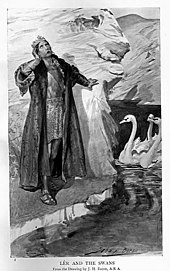
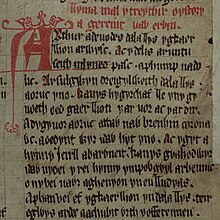
Gereint vab Erbin. Arthur a deuodes dala llys yg Caerllion ar Wysc...
(Geraint the son of Erbin. Arthur was accustomed to hold his Court at Caerlleon upon Usk...)
Important reflexes of British mythology appear in the
in Irish and earlier Indo-European tradition) in the Fourth Branch are major figures, but the tales themselves are not primary mythology.While further mythological names and references appear elsewhere in Welsh narrative and tradition, especially in the tale of Culhwch and Olwen, where we find, for example, Mabon ap Modron ("Divine Son of the Divine Mother"), and in the collected Welsh Triads, not enough is known of the British mythological background to reconstruct either a narrative of creation or a coherent pantheon of British deities. Indeed, though there is much in common with Irish myth, there may have been no unified British mythological tradition per se. Whatever its ultimate origins, the surviving material has been put to good use in the service of literary masterpieces that address the cultural concerns of Wales in the early and later Middle Ages.
Remnants of Gaulish and other mythology
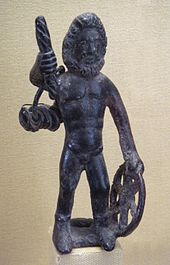
The Celts also worshiped a number of deities of which little more is known than their names. Classical writers preserve a few fragments of legends or myths that may possibly be Celtic.[13]
According to the Syrian rhetorician Lucian, Ogmios was supposed to lead a band of men chained by their ears to his tongue as a symbol of the strength of his eloquence.
The first-century Roman poet Lucan mentions the gods Taranis, Teutates and Esus, but there is little Celtic evidence that these were important deities.
A number of
Along with dedications giving us god names, there are also deity representations to which no name has yet been attached. Among these are images of a three-headed or three-faced god, a squatting god, a god with a snake, a god with a wheel, and a horseman with a kneeling giant.[15] Some of these images can be found in Late Bronze Age peat bogs in Britain,[16] indicating the symbols were both pre-Roman and widely spread across Celtic culture. The distribution of some of the images has been mapped and shows a pattern of central concentration of an image along with a wide scatter indicating these images were most likely attached to specific tribes and were distributed from some central point of tribal concentration outward along lines of trade. The image of the three-headed god has a central concentration among the Belgae, between the Oise, Marne and Moselle rivers. The horseman with the kneeling giant is centered on either side of the Rhine. These examples seem to indicate regional preferences of a common image stock.[15]
Julius Caesar on Celtic gods and their significance
The classic entry about the Celtic gods of Gaul is by Julius Caesar's history of his war in Gaul.[17] In this he names the five principal gods worshiped in Gaul (according to the practice of his time, he gives the names of the closest equivalent Roman gods) and describes their roles:
Mercury was the most venerated of all the deities and numerous representations of him were to be discovered. Mercury was seen as the originator of all the arts (and is often taken to refer to Lugus for this reason), the supporter of adventurers and of traders, and the mightiest power concerning trade and profit.
Next the Gauls revered
In addition to these five, Caesar mentions that the Gauls traced their ancestry to
).See also
References
- ISBN 0-19-815010-5, pp. 183 (religion), 202, 204–8.
- ISBN 0-901282-29-4.
- ISBN 0-552-54021-8.
- ISBN 978-0-14-021211-2.
- ISBN 0-552-54021-8.
- ^ Koch, John (2006). Celtic Culture: A Historical Encyclopedia. ABC-CLIO. p. 1326.
- ^ Carey, John (2006). "Tuath Dé". In John T. Koch (ed.). Celtic Culture: A Historical Encyclopedia. ABC-CLIO. pp. 1693–1697.
- ^ Ó hÓgáin, Dáithí (1991). Myth, Legend & Romance: An encyclopaedia of the Irish folk tradition. Prentice Hall Press. pp. 312–315, 407–409.
- ISBN 1-86019-709-4.
- ISBN 1-86019-709-4.
- ISBN 9780141941394.
Three gods patronize the crafts: Goibniu, Credne and Luchta.
- ^ ABC-CLIO. p. 995.
- ISBN 2-228-88621-1.
- S2CID 163788425.
- ^ a b Powell, T.G.E. (1958). The Celts. London, UK: Thames & Hudson.
- ^ Chadwick, Nora (1970). The Celts. Pelican Books.
- ^ Caesar, Gaius Julius. Commentarii de Bello Gallico [The Gallic War].
- ISBN 0-8414-6043-4.
- ISBN 0-552-54021-8.
| Mythology |
|---|
Bibliography
- de Vries, Jan, Keltische Religion (1961).
- Duval, Paul-Marie, Les Dieux de la Gaule, new ed. updated and enlarged (1976)
- Mac Cana, Proinsias. Celtic Mythology. New York: Hamlyn, 1970. ISBN 0-600-00647-6
- Mac Cana, Proinsias, The Learned Tales of Medieval Ireland (Irish Literature – Studies), Dublin Institute for Advanced Studies (1980): ISBN 1-85500-120-9
- MacKillop, James, Dictionary of Celtic Mythology. Oxford: Oxford University Press, 1998. ISBN 0-19-280120-1
- ISBN 978-0-85115-660-6
- O'Rahilly, Thomas F. Early Irish History and Mythology (1991, reissued 1971)
- Rolleston, T.W. Celtic Myths and Legends. Dover Publications Inc. (1911, 1990 reprint). ISBN 0486265072
- Rhys, John, Lectures on the Origin and Growth of Religion as Illustrated by Celtic Heathendom 3rd ed. (1898, reprinted 1979)
- Sjoestedt, M. L., Gods and Heroes of the Celts. 1949; translated by Myles Dillon. repr. Berkeley, CA: Turtle Press, 1990. ISBN 1-85182-179-1
- Squire, Charles. Celtic Myth and Legend. Newcastle Publishing Co. 1975. ISBN 0-87877-030-5
- Stercks, Claude, Éléments de cosmogonie celtique (1986)
- B.-O. UnbegaunLes Religions des Celtes, des Germains et des anciens Slaves (1948)
External links
 Media related to Celtic mythology at Wikimedia Commons
Media related to Celtic mythology at Wikimedia Commons- Celtic Art & Cultures: a detailed description of the Gundestrup cauldron
- Celtic Religion – What information do we really have (archived 9 February 2010)
- What We Don't Know About the Ancient Celts

